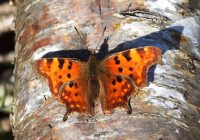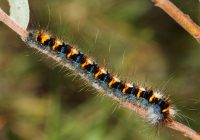Dr Phil Smith’s Wildlife Notes
October 2013
October is usually one of the wettest months and so it proved to be this year, though we missed the big storm that hit the south of England on 28th. It was also relatively warm, meaning that several late summer insects were active, at least on the drier days. Thus, a Northern Dune Tiger Beetle was a welcome sight on Birkdale Green Beach on 5th, while Migrant Hawkers and Common Darters persisted to the third week of the month. The male Black Darter I found in late September was still present at Birkdale slack 47 on 5th, basking on bare sand created during the earlier pond restoration. On 17th, Freshfield Dune Heath Nature Reserve produced a richly coloured Comma, three Common Darters and six Small Coppers, this delightful butterfly having been hard to find for most of the summer. As usual, late-flowering Ivy provided a feast of nectar, a favourite patch in the Ravenmeols woodland attracting several Red Admirals and Commas.
An insect that seems to have done particularly well this summer is the Oak Eggar moth. Its hairy caterpillars feed on a wide variety of plants and, although they are quite small in October, Trevor Davenport and I counted as many as 26, mainly on Grey Willow, in and around slack 47. They hibernate as half-grown caterpillars with characteristic markings of orange and deep blue – very attractive in close-up.
Early in the month, I was joined by friends to resurvey an isolated area of young dunes on the shore opposite the northern end of Southport Marine Lake. Built from particularly shell-rich sand, this dune fragment was destroyed in 2002 during works on the seawall but had reformed by 2008, supporting 61 different plants. Our new survey showed that, five years on, it had nearly doubled in size and now had as many as 87 plants. Significant additions included Portland Spurge, Eyebright and Common Milkwort showing that the sand is becoming less mobile. The site is also notable for the presence of the rare and endemic Sandhill Rustic moth, found here by Graham Jones and Richard Burkmar in 2009 and still present this year.
On 10th, I joined a group of enthusiasts guided by an expert in mosses and liverworts, Des Callaghan, who had conducted a survey of the Sefton Coast for extremely rare species, some of which had not been seen for decades. During a fascinating afternoon, he showed us the almost mythical Petalwort (Petalophyllum ralfsii), a tiny liverwort which resembles a miniature lettuce and then the Sea Bryum moss (Bryum warneum), both being national Biodiversity Action Plan Priority species. The southern part of Birkdale Green Beach is the British headquarters for Sea Bryum, while Des also found it at Devil’s Hole, Ravenmeols.
Another enjoyable afternoon was spent on Ainsdale National Nature Reserve with site manger Dave Mercer and Patricia Lockwood checking the bushes of the hybrid willow Salix × doniana. As well as re-finding the five known bushes, we also spotted two new ones, bringing the Sefton Coast total of this great rarity to 32. There are only three more specimens known in the rest of Britain. We were also delighted to see huge numbers of Field Gentians, some still in full flower. In 2009, we established that the reserve had the largest British population of this declining species and that its abundance was linked to a combination of winter sheep-grazing and year-round Rabbit activity that maintains a short sward around slack edges. Fortunately, there still appear to be large numbers of Rabbits on these dunes, populations being much reduced elsewhere.
Garden-escapes are a feature of our dune flora, a spectacular new arrival being Common Morning-glory flowering at Falklands Way close to a variegated Mugwort which has still not been named, even by experts, three years after its discovery.
One of the main threats to sand-dune biodiversity is the invasive Sea Buckthorn, introduced here in the 1890s. Together with Sefton’s Coast & Countryside Service, I organised two “buckthorn bashes”, following up last autumn’s work to cut regrowth in the slacks west of Sands Lake, Ainsdale. Groups of eight and thirteen volunteers put in a good shift for two hours on both occasions. It was noticeable that the bushes cut last year were much smaller, our experience being that repeated cutting over three or four years can get rid of this major pest. This is particularly worthwhile, as over 5000 Grass-of-Parnassus plants were counted here by Claire Boardman and Brian Wilby during our recent coastwide survey.




